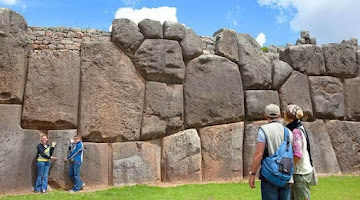How Did the Ancient South Americans Construct Massive Walls?
- I should add buildings as well, since some aspects of the techniques used range from Egypt to South America.
- The first is rock softening.
- Rock Softening
- Hiram Bingham roamed South America in the early 1900s and is credited with rediscovering Machu Picchu in 1911. He relates the following:
- The modern Peruvians are very fond of speculating as to the method which the Incas employed to make their stones fit so perfectly. One of the favourite stories is that the predecessors to the Incas knew of a plant whose juices rendered the surface of a block so soft that the marvellous fitting was accomplished by rubbing the stones together for a few moments with this magical plant juice! By the time the Incas came along, they had to use much smaller stones (as seen in the background). The original methods had been forgotten.
- Sacsayhuaman – Top Attraction in the City tour of Cusco

- Quarry at ancient Ollantaytambo In the Sacred Valley Of Peru, showing row of moulded stones ready to be split apart

- Moving onto Egypt.
- The work of geopolymer expert Joseph Davidovits is relevant to the discussion of stone softening. He has put forward compelling arguments that the ancient Egyptians built some of their major pyramids and temples using rock softening techniques. Soft limestone was soaked in water to turn it into a slurry and was then mixed with ingredients such as kaolin, natron salt and lime. The mixture was then poured and compacted into moulds, where it hardened into synthetic stone blocks, 95% of whose weight consisted of natural limestone. Samples of pyramid blocks examined under an optical microscope appear to be natural rock; it is only under an electron microscope or during X-ray analysis that evidence of synthetic constituents emerges.
- A 2006 study by materials engineer Michel Barsoum and his colleagues supported Davidovits’ claims that some of the blocks used in the pyramids were made from a limestone-based form of concrete. Using scanning and transmission electron microscopy, they found that pyramid samples had mineral ratios that did not exist in any known limestone sources.
- Now for moving the huge stones around and positioning them precisely.
- You can see above that there are indents or bumps on their surfaces. These were used to place the featherweight, hardening stones into place, and use their own weights to settle into exact fits.
- How did the ancient Maya build their majestic pyramids? Come to that, how did any of the pyramid builders build them? The Earth contains so many of them in different continents. It is hard not to wonder when you witness the sheer scale of them. So how did they do it? What sort of technology or machine allowed them to build such structures? Well, according to locals in the south of the Yucatán Peninsula, it wasn’t a machine at all. It was whistling.
- Ancient Mayas, some people believe, could move things by whistling. They would blow a tune, and heavy objects, such as stone and the wood they obtained from the forests, would follow their command, floating mid-air and moving wherever they were told. Just picture that scene: the construction site of a shrine devoted to the gods where there is no noise, no banging of hammers or rattling of cranes, just stones that glide into place guided by music in the wind.
- However, one day that power was lost. Someone broke the secret and desecrated ancient knowledge by using modern tools. The music lost effect. Stone and timber would never answer to the sound of whistling ever again.
- It is not hard to believe that the predecessors to the Incas and other South American races also possessed these skills at levitation.
